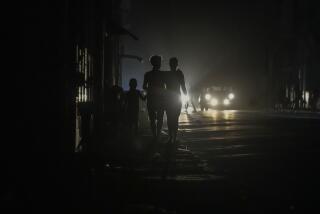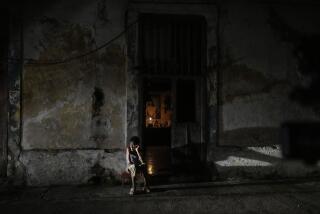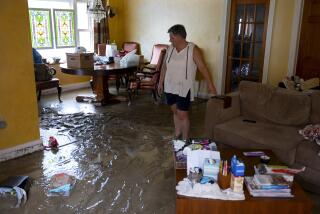Massive Blackout Hits the East
NEW YORK — An electrical malfunction plunged much of the northeastern United States and parts of Canada into a power blackout Thursday afternoon, sending anxious throngs into the streets in New York City, Cleveland, Detroit, Toronto and Ottawa and trapping thousands of people at airports, in elevators and on subways.
Nuclear power plants, caught without electricity needed to operate, shut down throughout the area. Prisons and hospitals switched to backup generators. Traffic signals blinked out. Stores closed because they had no lights or power for cash registers. Cellphone circuits jammed. People lined up at pay telephones, and many workers trudged home on foot.
As the blackout rolled across vast portions of the Northeast and southeastern Canada, officials estimated that it affected as many as 50 million people. Gov. George E. Pataki said half of the 19 million people in New York state were without power. Officials in Canada said as many as 10 million were affected there.
Canadian officials blamed the outage on lightning at an electrical plant near Niagara Falls, N.Y. But Brian Warner, an official at the New York Power Authority, denied that lightning had struck the facility and said the plant was operating. Other U.S. officials said they were investigating the possibility that the blackout was caused by a transmission problem from Canada.
“There is no evidence whatsoever of terrorism,” New York Mayor Michael R. Bloomberg told a news conference shortly after 6 p.m. EDT, two hours after the blackout struck. He said power in New York City “was starting to come back.... It will take a decent amount of time, hours, not minutes.” By 10 p.m., up to 15% of the power in the city had been restored.
President Bush, during a stop in San Diego on a two-day visit to California, declared: “Slowly but surely, we’re coping with this massive, national problem.” He said he would order an investigation into why the blackout was so severe. Bush said he suspected that the nation’s electrical grid needed to be modernized.
The blackout was the worst U.S. outage in seven years, almost to the day. On Aug. 11, 1996, high temperatures and overworked air conditioners caused an electrical failure that affected 4 million utility customers in nine Western states, stretching from Oregon into Mexico and as far east as Texas. That outage lasted up to 10 hours.
There were no early reports of hospitalizations in New York during Thursday’s outage, Bloomberg said, despite the lack of air conditioning as Manhattan temperatures reached 88 degrees. Nor were there reports of significant fires or of “criminal activity of any size,” the mayor said. “I expect everything to be back to business tomorrow.”
Officials in other cities offered similar reports.
In Detroit, Glen Woods, a police spokesman, said: “The city is down, but we’ve seen no major problems whatsoever. People are just heading home.” The worst thing officers encountered, Woods said, was an exceptionally long line at the border crossing to Windsor, Ontario.
Tunnels under the Detroit River connecting the two cities went dark for a while, Woods said, as did customs booths on both sides of the border.
The blackout started about 4:15 p.m., according to officials at the North American Reliability Council, an industry-supported organization that works to prevent power failures in the U.S. electrical grid.
“It’s a grid, and if you’ve got a problem in one area, it can cascade like dominos into others,” said a federal energy official in Washington. “The power grid east of the Mississippi is all one interconnection.... It can happen anywhere.”
Among the first to react were air-traffic controllers, whose computer systems were switched to backup power. Nonetheless, hundreds of flights and thousands of travelers were delayed as major airports in the New York area and the Midwest shut down because they lacked electricity to run baggage conveyors, jetways and security screening machines.
As a result, the Federal Aviation Administration canceled all flights to Newark, La Guardia and John F. Kennedy airports for several hours, as well as flights to Cleveland. Other incoming flights were canceled at Toronto and Ottawa. By late Thursday, all six airports had resumed full operations.
In Detroit, only incoming Northwest Airlines flights were halted, said FAA spokeswoman Laura Brown. In Chicago, American Airlines grounded its eastbound aircraft.
Planes were allowed to take off from affected airports if passengers and luggage had been screened, Brown said.
She said the airlines experienced no safety problems.
Chaos at Detroit International Airport showed how much air travel depends upon electricity. As night fell, only the control tower and runway lights -- both powered by generators -- were operating. Terminals, bathrooms, parking garages and security areas were dark.
Electrically operated doors were held open by ropes fashioned from plastic garbage bags. X-ray machines and metal detectors were down, and jetways were stalled. Air conditioning was out, and hallways were sweltering.
Using battery-operated bullhorns, airport workers pleaded with travelers to go home or find a hotel. Most complied.
“We had one departure at about 6 p.m.,” said Barbara Horgan, the airport spokeswoman, adding with mock enthusiasm: “Oooh, how exciting.”
Just after the sun went down, the lights came up.
“It got everyone’s hopes up,” Horgan said. “Then, of course, it went dark again.”
In downtown Detroit, cars on Interstate 75 jammed to a halt. They parked in a long line stretching to the north of Auburn Hills.
Finding gasoline became a problem.
“It’s just terrible,” said Gail Donahue, 44, in a car with four young daughters. “We just started driving around looking for ice and water. It’s basically wherever we can find some before we run out of gas.”
Among others who reacted quickly were New Yorkers caught in high-rise elevators.
Joe Guerrero, 49, the handyman at an apartment building on East 38th Street, was riding a service elevator when it stopped at the eighth floor and refused to move.
“It was a nightmare,” Guerrero said. Finally, he managed to open the door and flee.
David Schneider, who works in the electrical systems business, climbed stairs in two apartment houses.
First, he went to his own apartment on the 15th floor of one building. Then he climbed 32 flights in another to check on his fiancee’s sister, who is pregnant. “She was alone,” he said. “She was panicked.” Schneider worried that she would go into labor and considered writing “a lot of notes” and dropping them out a window.
After she calmed down, Schneider left. He climbed back down 32 flights and then realized he had left a candle burning back in his own apartment. “I had to go back up and blow out the candle.”
At his news conference in Manhattan, Bloomberg praised New Yorkers for remaining calm and cooperating with each other and with authorities. Thousands were trapped in the city’s subways, the mayor said, but “evacuation procedures are working ... and they are getting out.”
By 10 p.m., all subways had been emptied without mishap. Transit officials said full service would be restored six to eight hours after electricity returned.
Bridges and tunnels were closed to Manhattan-bound traffic, Bloomberg said, so all lanes could be used for vehicles and pedestrians leaving the city. Emergency shelters opened for people who could not get home.
Mindful of summer heat and the fact that “many people have walked down a lot of stairs,” he urged New Yorkers to drink plenty of water and keep their windows open. He also asked residents to turn off appliances to avoid a potentially damaging power surge when the electricity returned.
Near Pennsylvania Station, one of New York’s main railroad hubs, a crowd was trapped on the 4:04 train to Babylon on Long Island when it stalled on the tracks.
“The train was about 2 1/2 miles into the tunnel outside the city before the power went out,” said Steve Gorgone, a scanner operator for a graphic arts company, who was on board.
All the passengers could do was wait. The temperature in train cars began rising. Finally, some men knocked out the windows of the bar car to get air.
People panicked slightly, Gorgone said, because they had no idea what the problem was at first. Eventually, a diesel locomotive arrived to haul the 4:04 back to Penn Station.
At the United Nations, dozens were stuck in elevators between floors. Officials turned on three emergency generators, and the elevators descended with an hour. Because traffic was stalled, some diplomats and staff prepared to spend the night in their offices. Others tried to buy bicycles.
At Conrad’s Bike Shop, along the East River, where the U.N. compound sprawls, dozens knocked on the window and begged staffer John Tsang for professional racing bikes, built from the frame up.
Tsang explained over and over that none of the bikes was assembled.
“I have no bikes,” he said. “Nothing to rent. Nothing to sell.”
Then he unfolded his own compact bicycle.
“This is my emergency bike,” he said, and he pedaled away.
In Lower Manhattan, a sense of calm prevailed. The Brooklyn Bridge was packed with pedestrians. It bore an eerie resemblance to the flight from Manhattan on Sept. 11, 2001, after terrorists had flown airliners into the World Trade Center.
This time, however, people were in no rush.
A group of about 100 members of the Generation Day Camp, who had come from Brooklyn to see an off-Broadway play, lounged on the grass outside City Hall with hundreds of others waiting for the bridge to clear and the power to return.
As the youngsters laughed and played patty-cake, counselor James Williams, 22, chipper despite a 5-mile walk ahead, said they were not worried.
But he was doubtful about what had happened.
“I think something happened they don’t want to tell us,” Williams said. “I think this is a whole lot more serious than they are saying.”
Tess Valladares, nearly in tears, asked a police officer which way to walk to reach the Bronx, the uppermost borough in the city. The policeman said it was a several-mile walk.
“You better park yourself in the park,” said a bystander, “ ‘cause that’s way too far.”
Hector Bosa, 36, a legal assistant, said one or two people in his office “were thinking 9/11. I tried to calm them down.”
Some New Yorkers found themselves facing problems they had never encountered. Credit-card verification systems were out of order. So were automated-teller machines.
“We’re looking for a bar that takes credit cards on the honor system,” said Dan Nall, 25, a consultant partying with friends. One said the group had come up with a sure-fire money-making scheme: generator-powered ATMs.
As midnight approached, lights began to flicker on in the Bronx, Brooklyn and Queens, but most of Manhattan and Staten Island were still dark.
Times Square was spooky. It had none of the lights that make its nights as bright as day. Tourists turned the square into a party. Artists sketched portraits, break dancers performed, a rollerblader hitched a ride by holding onto the back of a truck.
To the west, officials said Cleveland was running out of water because there was no electricity to pump it from Lake Erie.
“We’re fighting time here,” water commissioner Julius Caicca told Associated Press. Ralph DiNicola, spokesman for First Energy Corp, a public utility holding company, said bringing electricity back online in northern Ohio could take days.
At Herb’s Tavern in Rocky River, near Cleveland, workers put a “closed” sign in the window. “We ... fired up our huge icemaker,” said Kyle Rudy, a busboy. “We have insulated coolers in the basement, so we’re just dumping ice on everything and hoping the electricity comes back soon.”
In Canada, the capital of Ottawa was cast into darkness. Just across the Ottawa River, however, lights twinkled in Gatineau, Quebec, which has its own power grid.
Ottawa residents drove across the river to fill their cars at working gas stations and buy ice cream in air-conditioned stores.
“At least it’s not the middle of winter,” said Staff Sgt. Eric Martinat of the Ottawa police. “People are firing up the barbecue and jumping into the kiddie pools.”
In Toronto, city officials gave an emergency center, installed for the millennium change, its first real test. The mayor, fire chief and police chief gathered at the undisclosed location to oversee recovery.
The blackout made the commute home an arduous one.
Beth Resend, who is pregnant, walked home with a travel industry colleague along Yonge Street, Toronto’s main north-south thoroughfare. She was one of thousands on foot. “It’s all very bizarre,” Resend said. “Very weird.”
Restaurants along Yonge Street handed out containers of water.
Douglas Donald converted his midtown Toronto home into a makeshift barbecue stand. He grilled meat other people brought by and offered glasses of red wine.
“You don’t even think about it,” Donald said. “You just go and do it.”
As darkness fell in Toronto and Manhattan, many lingered on the streets. Few buildings were lighted -- only those with emergency generators. There were occasional tiffs over taxis and space on buses.
Doormen held candles at the entrances to apartment buildings and used flashlights to guide residents upstairs.
Outside some buildings, residents gathered around candles on the stoops.
In a city that never sleeps, people looked up at a sight they rarely saw: the stars.
*
(BEGIN TEXT OF INFOBOX)
Blackout effects
The repercussions of the multi-state power outage:
*Air traffic: New York’s three major airports were closed for hours, and flights from around the country to Detroit, Cleveland, Ottawa and Toronto were canceled.
* Money: The blackout came after financial markets had closed and no data were lost.
Automated teller machines shut down, turning affected areas into cash-only economies.
* Nuclear power: Nine nuclear power plants automatically shut down in four states: New York, New Jersey, Ohio and Michigan.
* Water: Cleveland officials warned of shortages, with no electricity to pump water to 1.5 million people.
Sources: Staff reports, Associated Press
Researched by Times graphics reporter Kristen Walbolt
*
The following Times staffers and special correspondents contributed to the blackout coverage: Thomas S. Mulligan, Eric Slater, John Beckham, Maggie Farley, Edwin Chen, Jessica Garrison, Richard B. Schmitt, Andrew VanVelzen and Tom Crouch. Chicago Tribune reporter Brett McNeil in Detroit also contributed.
More to Read
Sign up for Essential California
The most important California stories and recommendations in your inbox every morning.
You may occasionally receive promotional content from the Los Angeles Times.










